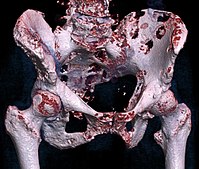
Photo from wikipedia
Background Denosumab is a monoclonal RANKL antibody, which was originally introduced for the treatment of osteoporosis and bone metastases from solid tumors, but more recently has been used for treatment… Click to show full abstract
Background Denosumab is a monoclonal RANKL antibody, which was originally introduced for the treatment of osteoporosis and bone metastases from solid tumors, but more recently has been used for treatment of giant cell tumor of bone (GCTB). In GCTB, denosumab has been used as a single agent in patients with inoperable tumors; it also has been used before surgery in some patients with the aim to downstage the tumor to facilitate a joint-preserving procedure (curettage) rather than a resection. However, few studies are available evaluating the benefits and risks of denosumab for the latter indication. Questions/purposes (1) Does preoperative treatment with denosumab reduce the risk of local recurrence in patients treated for GCTB? (2) Are there adverse effects of short-term denosumab use before surgery and, if so, what are they? Methods All patients with a diagnosis of GCTB surgically treated at our institution from June 2009 to June 2016 with curettage and cryotherapy were retrospectively evaluated to compare patients treated with curettage alone versus patients treated with curettage after preoperative therapy with denosumab. During that period, we treated 97 patients for GCTB; 30 patients were excluded because they received a resection; 34 patients were excluded because they received curettage without cryotherapy. Of the remaining 33 patients, four were excluded because they received denosumab only after surgery, one because she received zoledronic acid, one because she received a curettage after her refusal of a resection that was the advised procedure, two because they were lost to followup early, and four because they were treated for recurrence rather than a new diagnosis of GCTB. The remaining 21 patients were included. Twelve lesions had been treated with surgery after denosumab and nine with surgery alone. During the study period, we preferentially used denosumab for the more aggressive-looking lesions. After curettage, cryotherapy of the residual bone walls was performed with argon cryoprobes to -150° C after pouring gel into the cavity, and we then used cement (17 patients) or morcellized allograft (four patients). Tumors were Campanacci Grade 3 in eight of 12 patients in the denosumab group and in two of nine patients in the surgery-only group (p = 0.08), but the extent of epiphyseal juxtaarticular bone involvement was not different between the groups with the numbers available. Median followup was 39 months (range, 14-55 months) in the denosumab group and 27 months (range, 18-92 months) in the surgery-only group. We used chart review to record the proportion of patients in each treatment group who had a local recurrence and to tally adverse events. Results With the numbers available, there was no difference in the proportion of patients experiencing a recurrence (five of 12 in the denosumab group and one of nine in the surgery-only group; p = 0.18). We found no adverse effects associated with denosumab either during or after treatment; specifically, we found no alterations in electrolyte levels, blood count, or liver and renal function parameters. In this small series, no patient has developed osteonecrosis of the jaw. Conclusions In this small series, use of denosumab before surgery for GCTB appeared to allow the reforming of a bone peripheral rim around the tumor, perhaps facilitating curettage rather than osteoarticular resection in some patients. However, we did not observe a decrease in the risk of local recurrence with the use of denosumab, suggesting that it may not decrease the aggressiveness of the disease; according to our preliminary results, we cannot exclude that the rate of local recurrence could be even higher after curettage in denosumab-treated patients than in nontreated patients, and until or unless larger studies demonstrate such a reduction, primary intralesional surgery without denosumab seems more prudent when curettage is feasible at presentation. We did not observe any adverse effects with denosumab, but we caution readers that this study was underpowered to detect even relatively common complications and relatively large differences in the risk of local recurrence. Future studies should evaluate denosumab prospectively; given the relative rarity of this tumor, we suspect multicenter studies are needed to achieve this. Level of Evidence Level III, therapeutic study.
Journal Title: Clinical Orthopaedics and Related Research
Year Published: 2018
Link to full text (if available)
Share on Social Media: Sign Up to like & get
recommendations!